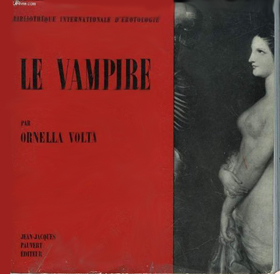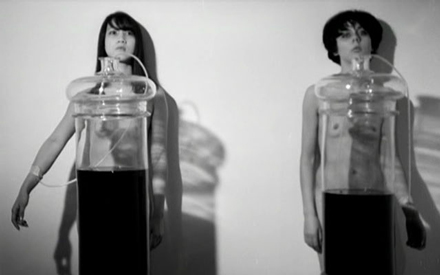
 |
|
|
|
Some formerly obscure horror films need to be seen, as they are deserving of the accolades denied them when they were new. On this list I would place John Parker's Dementia, Willard Huyck and Gloria Katz's Messiah of Evil and Richard Blackburn's Lemora: A Child's Tale of the Supernatural. Others need to be seen ... just to see what the noise was all about, I suppose. Back in the 1980s Phil Hardy's The Encyclopedia of Horror Movies gave us the titles and the filmmakers for at least 150 mystery shows we'd scarce heard of. Most of us had no way of tracking any of them down until the advent of DVD. The flood of Argentos, Bavas, Blind Dead pics, Coffin Joe pix and gruesome J-Horror yielded some atmospheric winners like Mill of the Stone Women and Moju, the Blind Beast, but also a lot of intriguing-sounding but woefully insubstantial Jesus Franco movies. 
Thanks to early issues of the magazine Cinefantastique, I was well aware of the horror pix of Jean Rollin, yet was in no hurry to see them -- the stills alone told me that many were soft-core romps more interested in female nudity than horror. Back in UCLA's Theater Arts Reading Room we had a tantalizing European book that made me want to learn French, like overnight. Le Vampire by Ornella Volta (1962) discussed all kinds of horrific subjects but concentrated on horror art and horror movies -- with fascinating and sometimes revolting reproductions of surreal horror paintings. A modern vein developed visual seemingly related to the silent Feuillade serials, with mystery women wearing bat-masks, etcetera. I think that Jean Rollin was inspired by this art, and for all I know, Ornella's book. It remains a largely untouched reservoir of macabre imagery. 1 According to Tim Lucas' exhaustive disc liner notes Jean Rollin's first feature The Rape of the Vampire was filmed under unusual circumstances. Rollin tossed his script after three days, as it called for crane shots, etcetera, that he simply lacked the resources to shoot. The film was improvised as it went along, with the result that its storyline plays like a fractured serial narrative with major chapters missing. The crazy story isn't really Rollin's fault. Hired to make a short subject to accompany another horror release (actually, a 1940s American film not seen in France), Rollin was commissioned halfway into production to turn the whole thing into a feature. This is why the single feature film has two stories, separated by a "part 2" title in the middle; the second half is less bitty and a bit better organized than the first. 
Believe me, a detailed synopsis of The Rape of the Vampire would only cause headaches. Part one sees a doctor traveling to the country to convince four sisters that they are not supernatural bloodsucking vampires. His rational approach brings about several unnecessary deaths before the locals, behaving in approved Universal fashion, carry out a cruel retribution against the vampire women. I could be wrong, but I believe the upshot is that the vampirism is real, but turns out to be a medical disease; the semi-satanic rites are a symptom rather than a cause. Part 2 gets serious about establishing a reign of terror among a larger group of vampires. Their queen forces research to cure the vampirism but the stalking and murders continue. Imagine a vampire story filmed with some Judex-like stylistic flourishes but almost nothing else except constant nudity, and you pretty much have The Rape of the Vampire pegged. Rollin's energetic (and certainly game) cast go through the motions but very little in the way of cinematic effect is created. It's all a step up from backyard production. Even though he has the cooperation of a large group of friends, Rollin seems more of a party organizer than a director. As obsessed filmmakers go, Rollin comes out second-best against someone like, say, the lowly Ray Dennis Steckler, who pasted his movies together with zero resources yet maintained a middling feeling of authorial control. 
The Hardy Encyclopedia's entry for this title claims that the actors were purposely reduced to 'formal elements' rather than developed as characters, but to our eyes it just seems that Jean Rollin isn't up to the job of working with his mostly non-pro actors. "His films refuse to give characterization priority over visuals and rhythm", claims the entry, but we don't see much in the way of visual dexterity, and certainly no hint of cinematic rhythm. Rollin reaches for striking images and consistently falls short. We're told that the concluding rituals, conducted amid the least engaging stage design imaginable (see illustration, above) were filmed in the actual Theater of Grand Guignol, not long before it was torn down. The way Rollin films it, it might as well be a High School auditorium -- we don't even see the legendary carved figures that were said to adorn the rafters. A scene featuring two nude vampire girls feeding from bottles of blood (pictured below) may have been inspired by surreal art, but Rollin's composition and execution is deadpan literalism. Perhaps that approach has hidden merits I don't see; what I do see is a filmmaker straining for effects and coming up short. The availability of a nude beach (and actresses willing to brave the chilly air) dominates part of the second half of the film, where scenes are blocked and played out like a clumsy pageant. Nudes are present in most every scene, but not to any particular erotic effect. The wicked queen generates a bit of camp appeal, yet no attachment forms to anybody. Even when Rollin opts for a poetic finale -- which to him simply means superimposing spoken poetry over the same slipshod images -- we get the feeling that we're seeing an art film / exploitation hybrid. 
In Redemption's ample, well-researched and produced extras we learn that The Rape of the Vampire was released at the time of the May '68 strikes and riots in Paris. We hear a rather romantic story about rioters discovering Rollin's film while avoiding the police by checking into a matinee. We also hear that the movie drew a crowd even as critics dismissed it as irrelevant. That's an interesting situation-- the politically charged critics fail to see anything in the show to support the general strike, while the college crowd goes to (presumably) ogle the female flesh on view. The Rape of the Vampire found its commercial niche in the tough Parisian cinema market. Rollin's subsequent films went their own way, against most trends in Eurohorror. I can see horror fans being mildly attracted to them; for me they're a stopping point of interest in a tour of a genre with something for every taste. Kino Lorber and Redemption's Blu-ray has done very well by Jean Rollin's The Rape of the Vampire, providing a clean and clear B&W image that brings detail out of poorly-lit scenes. The mostly attractive cast certainly looks better here than on the VHS bootlegs that once sold at horror conventions. If there was any film damage to speak of, I didn't notice it. Redemption has now brought the entire Rollin library to Blu-ray, I believe, which should make his fans very happy. The spoken language is French, with removable English subtitles. The extras give one plenty of food for thought. Tim Lucas's liner notes make valuable observations about the film, even as his classical associations seem somewhat forced. When applied to any but the most lofty examples of Eurohorror, the full-on Academic approach doesn't seem all that fruitful. Adding to our conviction that Rollin is a determined artist of limited range are two of his short films. The first could be the equivalent of our 'ethereal cereal' UCLA student films (I made my share). The second is an interesting fragment potentially more promising than his first feature. As Rollin owned his films and participates in most of the extras, there isn't much in the way of critical attention in the hefty documentary on The Rape of the Vampire (director Daniel Gouyette). One Rollin associate surprises us by saying that almost everybody hated it when it was new... but then reveals that all have recanted and now recognize the film's brilliance. The personable Jean Rollin and a colleague are given separate interviews, and Rollin offers a separate video introduction. A pair of trailers are present; that insert pamphlet with the critical analysis by Video Watchdog's authoritative Tim Lucas is well-illustrated and 16 pages in length. Kino Lorber's producer is Bret Wood.
On a scale of Excellent, Good, Fair, and Poor,
The Rape of the Vampire Blu-ray rates:
Footnote:
1. Just remembering that haunted book recalls macabre chills. A recurring theme depicts skeletons seducing nubile females. One skeletal symbol of death envelops his beauty in a cape seemingly made of insect wings. A particularly memorable and disturbing illustration is called "love without limits". It appears to picture a celestial cluster of stars and gas that is also a woman, half dissolved. What does it mean? That's like explaining a nightmare.
Reviews on the Savant main site have additional credits information and are often updated and annotated with reader input and graphics. Also, don't forget the 2011 Savant Wish List. T'was Ever Thus.
Review Staff | About DVD Talk | Newsletter Subscribe | Join DVD Talk Forum |
| ||||||||||||||||||